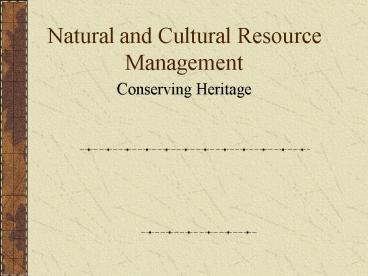Natural and Cultural Resource Management - PowerPoint PPT Presentation
1 / 29
Title:
Natural and Cultural Resource Management
Description:
Explain three factors that affect the standard of care that should be ... way in the semester Can you explain why 'Park Management' is not an oxymoron? ... – PowerPoint PPT presentation
Number of Views:138
Avg rating:3.0/5.0
Title: Natural and Cultural Resource Management
1
Natural and Cultural Resource Management
- Conserving Heritage
2
Quick Review
- What is an ICS?
- What two factors are used to measure risk?
- Why is risk management important?
- Explain three factors that affect the standard of
care that should be provided to park visitors.
3
Objectives
- Justify the need for management of protected
areas - Discuss key environmental threats and their
underlying causes - Explain the objectives, issues techniques
involved in vegetation management wildlife
management - Outline types of cultural sites and discuss
threats and associated management principles
4
Readings
- Worboys et al. 2005
- Chap 12 309-311, 343-350.
- Chap 13
- Chap 14 386-393
- Worboys et al. 2001.
- p. 179-181
- P. 218- 226
- P. 243-249
- Reference
- Green, R. J. and Higginbottom, K. 2000. The
effects of non-consumptive wildlife tourism on
free-ranging wildlife a review. Pacific
Conservation Biology 6 183-97.
5
Your are past half way in the semester Can you
explain why Park Management is not an oxymoron?
6
Threats to Protected Areas
- Biodiversity
- Soils / Geological Features
- Scenic quality
- Cultural heritage
7
Biodiversity Threats
- Pollution
- Fire
- Grazing
- Edge effects
- Encroachments
- Pest animals
- Weeds
- Habitat disturbance
- Visitor use
- Vandalism
- Illegal actions (eg. Collecting plants)
- Disease
8
Threats to Soils and Geological Features
- Erosion
- Soil, sand, gravel extraction
- Fossil or mineral collecting
- Collecting rocks for landscaping
- Damage to caves
- Introduced trace elements in soils
- Plant pathogens in soils (eg. Phytopthora
cinnamomi)
9
Threats to Scenic Quality
- Poor design and placement of infrastructure
- Clearing
- Inappropriate fire regimes
- Quarries
10
Why do these threats occur?
- Social factors
- Political factors
- Legal factors
- Ecological factors
- Economic factors
- Managerial factors
11
Minimising Environmental Threats
- Improved planning
- Linking public lands
- Partnerships between states
- Partnerships with private landowners
- Education and information
- Community participation in management
12
National Strategy for Conservation of Australias
Biodiversity
- Manage for biodiversity on a regional basis
- Conserve biodiversity in an integrated manner
- Establish a comprehensive, adequate and
representative system of protected areas - Strengthen off-reserve conservation
- Involve Aboriginal communities
13
National Strategy for Conservation of Australias
Biodiversity
- Integrate biodiversity conservation in
pastoralism, forestry, water management,
recreation etc. - Deal with threatening processes
- Improve knowledge base
- Involve the community
- Meet international convention requirements
14
Vegetation Management
- Objectives
- Protect endangered and significant plant species
- Restore natural vegetation to pre-European
condition - Protect and maintain diversity
- Rehabilitate disturbed areas
- Eradicate or control exotic flora
- Monitor vegetation changes
15
Issues
- Physical damage
- Weed species
- Protecting plants with commercial potential
- Preserving genetic diversity
- Reintroductions
- Fire
16
Fragile Vegetation
- Interpretation
- Barriers
- Harden site
- Closure
17
Techniques
- Thinning
- can improve wildlife habitat for certain species
- improves vigour of trees
- promotes individual trees you want to favour
- can improve aesthetics
- Mowing
- near roadways, can decrease road kill
- Historic Areas
18
Vegetation -- the Case for Removal
- Plants and hard surfacing
- Vista Cuttings
- Safety
- Sunlight
- Susceptibility to Impact
- Invisible Effects
19
Vegetation -- the case for More
- Screening
- Noise Reduction
- Shade
- Advance Planting
- Cover Planting
- Habitat Enhancement
20
Wildlife Management Objectives
- Conserve rare or significant native species
- Protect and maintain diversity by maintaining
suitable habitat - Control introduced species
- Undertake continuing research resource surveys
of native wildlife - Investigate the re-introduction of indigenous
fauna species no longer found in the area
21
Issues
- Endangered Species
- Reintroductions
- Feeding
- Unnatural Behaviours
- Stress
- Injured or sick animals
- Introduced disease
- Culling
- Hunting / Fishing
- Exotics
- Ferals
- Pets
- Native fauna as agricultural pests
22
Wildlife Management Techniques
- Separate visitors from wildlife
- Closure
- Information and Education
- Habitat manipulation
23
Conserving Cultural Heritage
24
Types of Cultural Heritage Sites
- Built (eg. Buildings, bridges, lighthouses)
- Modified (eg. Mining sites, gardens)
- Natural (eg. Fossil sites)
- Australian Aboriginal (eg. Rock art sites)
25
Key Steps in Heritage Conservation
- Identification
- Determine Significance
- Consider management constraints and opportunities
- Determine direction and priority of conservation
works
26
Common Management Techniques for Built
Environments
- Preservation or Stabilization
- Restoration
- Reconstruction
- Site integrity
- Adaptive Use
27
Examples of Aboriginal Sites
- Camp sites
- Middens
- Mounds
- Caves or rock shelters
- Scarred trees and carved trees
- Quarry sites
- Axe-grinding stones
- Burial sites
- Remains
- Rock Art
- Engravings
- Ceremonial Grounds
- Sacred Sites
28
Common Management Techniques for Aboriginal Sites
- Visitor Management Techniques
- Interpretation
- Tours
- Limit Information
- Closure
- Resource Mgt Techniques vary depending on nature
of site (eg. Water diversion for rock art sites)
29
Threats to Cultural Heritage
- Aboriginal Culture
- Disturbance to sites
- Misuse of site
- Vandalism
- Illegal collection
- Fire
- Tourism
- Non-Aboriginal Culture
- Fire
- Storms
- Floods, rising damp, salinity
- Vandalism
- Animals
- Tourism































